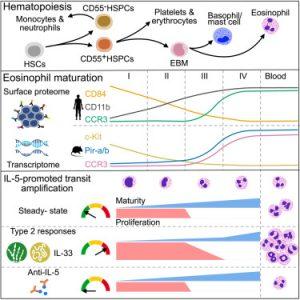Eosinophils, rare white blood cells named for their characteristic red staining, play a complex role in our immune system. While their exact functions remain under investigation, recent studies suggest they influence fat metabolism, tissue repair, and fight against infections and cancers.
However, eosinophils can also be troublemakers. In diseases like asthma and allergies, their numbers surge in the blood and tissues, a condition known as eosinophilia. This is a key diagnostic sign for these “eosinophil-associated diseases” and guides treatment.
Scientists know that a protein called Interleukin-5 (IL-5) fuels eosinophilia by boosting their production in the bone marrow. This led to the development of targeted treatments using monoclonal antibodies to block IL-5 for severe eosinophilic diseases.
To better understand eosinophils and their response to treatment, researchers recently conducted a detailed analysis of these cells at various stages of development (Figure 1). This study provides valuable tools and data for future research.
Interestingly, the study revealed a surprising truth about IL-5’s role. Previously, it was believed to directly promote the maturation of eosinophils. However, the research suggests IL-5 actually slows down their maturation, allowing them to multiply more extensively. This “transit amplification” explains how IL-5 fuels eosinophilia, and blocking it with targeted treatments effectively reduces eosinophil numbers.
This new understanding of IL-5’s function paves the way for further investigation into eosinophil biology and the development of more refined treatment strategies for eosinophil-associated diseases.
Journal article: Jorssen, J., et al. 2024. Single-cell proteomics and transcriptomics capture eosinophil development and identify the role of IL-5 in their lineage transit amplification. Immunity.
Summary by Stefan Botha











